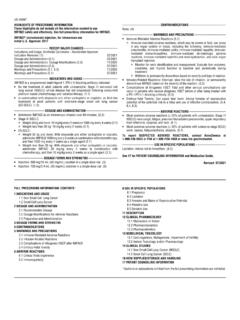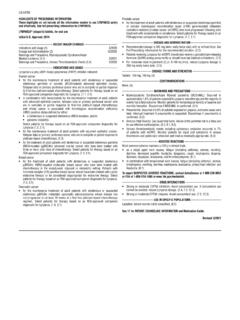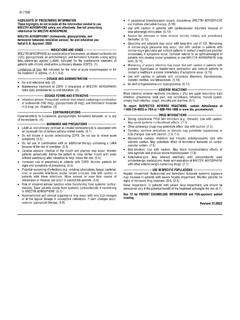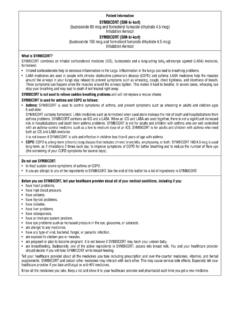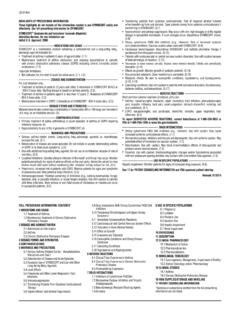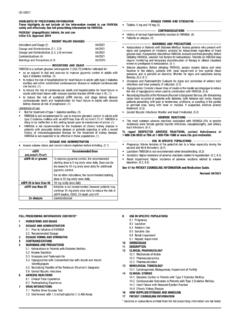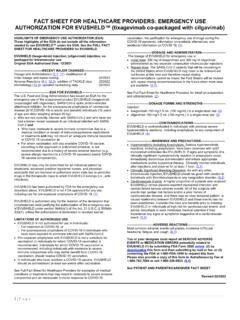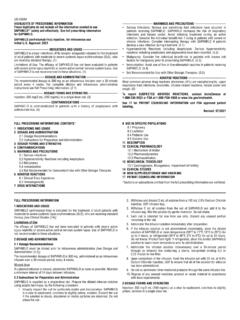Transcription of US-56427 ---------------------------- DOSAGE AND ...
1 HIGHLIGHTS OF PRESCRIBING INFORMATION These highlights do not include all the information needed to use BRILINTA safely and effectively. See full prescribing information for (ticagrelor) tablets, for oral use Initial Approval: 2011 WARNING: (A) BLEEDING RISK, and (B) ASPIRIN DOSE AND BRILINTA EFFECTIVENESS IN PATIENTS WITH ACSSee full prescribing information for complete boxed RISK BRILINTA, like other antiplatelet agents, can cause significant, sometimes fatal bleeding. ( , ) Do not use BRILINTA in patients with active pathological bleeding or a history of intracranial hemorrhage.
2 ( , ) Do not start BRILINTA in patients undergoing urgent coronary artery bypass graft surgery (CABG). ( , ) If possible, manage bleeding without discontinuing BRILINTA. Stopping BRILINTA increases the risk of subsequent cardiovascular events. ( )ASPIRIN DOSE AND BRILINTA EFFECTIVENESS IN PATIENTS WITH ACS Maintenance doses of aspirin above 100 mg daily reduce the effectiveness of BRILINTA and should be avoided. (2, , ) --------------------------------- RECENT MAJOR CHANGES -------------------------------Indicatio ns and Usage ( ) 11/2020 DOSAGE and Administration ( ) 11/2020 Warnings and Precautions ( , , , ) 11/2020 Warnings and Precautions ( ) 08/2021--------------------------------- INDICATIONS AND USAGE --------------------------------BRILINTA is a P2Y12 platelet inhibitor indicated to reduce the risk of cardiovascular (CV) death, myocardial infarction (MI)
3 , and stroke in patients with acute coronary syndrome (ACS) or a history of MI. For at least the first 12 months following ACS, it is superior to clopidogrel. BRILINTA also reduces the risk of stent thrombosis in patients who have been stented for treatment of ACS. ( ) to reduce the risk of a first MI or stroke in patients with coronary artery disease (CAD) at high risk for such events. While use is not limited to this setting, the efficacy of BRILINTA was established in a population with type 2 diabetes mellitus (T2DM).
4 ( ) to reduce the risk of stroke in patients with acute ischemic stroke (NIH Stroke Scale score 5) or high-risk transient ischemic attack (TIA). ( ) US-56427 ---------------------------- DOSAGE AND ADMINISTRATION ----------------------------- ACS or History of MI Initiate treatment with 180 mg oral loading dose of BRILINTA. Then administer 90 mg twice daily during the first year. After one year, administer 60 mg twice daily. ( ) Patients with CAD and No Prior Stroke or MI Administer 60 mg BRILINTA twice daily.
5 ( ) Acute Ischemic Stroke Initiate treatment with a 180 mg loading dose of BRILINTA then continue with 90 mg twice daily for up to 30 days. ( ) Use BRILINTA with a daily maintenance dose of aspirin of 75-100 mg. (2, )--------------------------- DOSAGE FORMS AND STRENGTHS --------------------------- 60 mg and 90 mg tablets (3)----------------------------------- CONTRAINDICATIONS ----------------------------------- History of intracranial hemorrhage. ( ) Active pathological bleeding. ( ) Hypersensitivity to ticagrelor or any component of the product.
6 ( )----------------------------- WARNINGS AND PRECAUTIONS ----------------------------- Dyspnea was reported more frequently with BRILINTA than with control agents in clinical trials. Dyspnea from BRILINTA is self-limiting. ( ) Severe Hepatic Impairment: Likely increase in exposure to ticagrelor. ( ) Laboratory Test Interference: False negative platelet functional test results have been reported for Heparin Induced Thrombocytopenia (HIT). BRILINTA is not expected to impact PF4 antibody testing for HIT. ( )---------------------------------- ADVERSE REACTIONS ------------------------------------Most common adverse reactions (>5%) are bleeding and dyspnea.
7 ( , , )To report SUSPECTED ADVERSE REACTIONS, contact AstraZeneca at 1-800-236-9933 or FDA at 1-800-FDA-1088 or DRUG INTERACTIONS ------------------------------------ Avoid use with strong CYP3A inhibitors or CYP3A inducers. ( , ) Opioids: Decreased exposure to ticagrelor. Consider use of parenteral anti-platelet agent. ( ) Patients receiving more than 40 mg per day of simvastatin or lovastatin may be at increased risk of statin-related adverse effects. ( ) Monitor digoxin levels with initiation of or any change in BRILINTA.
8 ( )---------------------------- USE IN SPECIFIC POPULATIONS ------------------------------ Lactation: Breastfeeding not recommended. ( )See 17 for PATIENT COUNSELING INFORMATION and Medication GuideRevised: 08/2021 FULL PRESCRIBING INFORMATION: CONTENTS*WARNING: (A) BLEEDING RISK, AND (B) ASPIRIN DOSE AND BRILINTA EFFECTIVENESS IN PATIENTS WITH ACS1 INDICATIONS AND Acute coronary Syndrome or a History of Myocardial coronary artery Disease but No Prior Stroke or Myocardial Acute Ischemic Stroke or Transient Ischemic Attack (TIA)2 DOSAGE AND Acute coronary Syndrome or a History of Myocardial coronary artery Disease but No Prior Stroke or Myocardial Acute Ischemic Stroke or Transient Ischemic Attack (TIA)
9 Administration3 DOSAGE FORMS AND STRENGTHS4 History of Intracranial Active Hypersensitivity5 WARNINGS AND Risk of Concomitant Aspirin Maintenance Dose for Patients Being Treated for Discontinuation of BRILINTA in Patients Treated for coronary artery Severe Hepatic Central Sleep Laboratory Test Interferences6 ADVERSE Clinical Trials Postmarketing Experience7 DRUG Strong CYP3A Strong CYP3A Simvastatin, Digoxin8 USE IN SPECIFIC Pediatric Geriatric Hepatic Renal Impairment10 OVERDOSAGE11 DESCRIPTION12 CLINICAL Mechanism of Pharmacogenetics13 NONCLINICAL Carcinogenesis, Mutagenesis, Impairment of Fertility14 CLINICAL Acute coronary Syndromes and Secondary Prevention after Myocardial coronary artery Disease but No Prior Stroke or Myocardial Acute Ischemic Stroke or Transient Ischemic Attack (TIA)
10 16 HOW SUPPLIED/STORAGE AND HANDLING17 PATIENT COUNSELING INFORMATION* Sections or subsections omitted from the full prescribing information are not PRESCRIBING INFORMATIONWARNING: (A) BLEEDING RISK, and (B) ASPIRIN DOSE AND BRILINTA EFFECTIVENESS IN PATIENTS WITH ACSA. BLEEDING RISK BRILINTA, like other antiplatelet agents, can cause significant, sometimes fatal bleeding ( , ). Do not use BRILINTA in patients with active pathological bleeding or a history of intracranial hemorrhage ( , ). Do not start BRILINTA in patients undergoing urgent coronary artery bypass graft surgery (CABG) ( , ).
